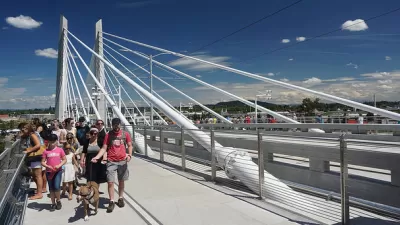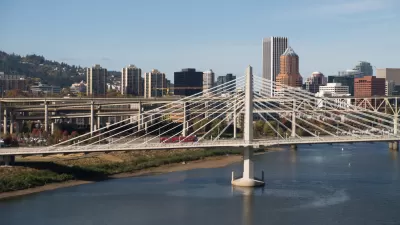The first bridge in the country to allow all forms of traffic except for cars opened for a public preview over the weekend. Tens of thousands of Portlanders showed up to enjoy the bridge.

"With walkers and in strollers, on hopalongs and (in the case of quite a few happily panting dogs) on leashes, Portlanders packed a series of previews Sunday of Tilikum Crossing, the first bridge in the United States to carry buses, bikes, trains, streetcars and people walking but no private cars," reports Michael Andersen.
A TriMet official spokeswoman present at the event estimated that between 40,000 and 50,000 people crossed the bridge on the preview day.
Andersen details the events of the day and provides a review of the bridge and its experience:
"Though I’d personally walked across the bridge once before, the experience of doing it on a bike was surprisingly different — in a great way. It’s a fine trip on foot with good views of the city and (especially) the river. But like the other Willamette Bridges, it’s just a long way to walk in the sun.
But on a bicycle, Tilikum really feels like a magic carpet. It’s so quiet, so low-stress, so open to the air and so physically beautiful that it’s clearly more pleasant to ride across than anything else except the Steel Bridge’s lower deck. Even when MAX, bus and streetcar will be thumping past on the center lanes, the thick separation between the bikeways and pillars will keep them from causing any stress at all."
The article includes a lot of photos of the new bridge, so everyone everywhere else in the country can live vicariously through this one of its kind infrastructure and architectural feature.
FULL STORY: By the tens of thousands, Portlanders preview their new car-free bridge

Alabama: Trump Terminates Settlements for Black Communities Harmed By Raw Sewage
Trump deemed the landmark civil rights agreement “illegal DEI and environmental justice policy.”

Planetizen Federal Action Tracker
A weekly monitor of how Trump’s orders and actions are impacting planners and planning in America.

The 120 Year Old Tiny Home Villages That Sheltered San Francisco’s Earthquake Refugees
More than a century ago, San Francisco mobilized to house thousands of residents displaced by the 1906 earthquake. Could their strategy offer a model for the present?

In Both Crashes and Crime, Public Transportation is Far Safer than Driving
Contrary to popular assumptions, public transportation has far lower crash and crime rates than automobile travel. For safer communities, improve and encourage transit travel.

Report: Zoning Reforms Should Complement Nashville’s Ambitious Transit Plan
Without reform, restrictive zoning codes will limit the impact of the city’s planned transit expansion and could exclude some of the residents who depend on transit the most.

Judge Orders Release of Frozen IRA, IIJA Funding
The decision is a victory for environmental groups who charged that freezing funds for critical infrastructure and disaster response programs caused “real and irreparable harm” to communities.
Urban Design for Planners 1: Software Tools
This six-course series explores essential urban design concepts using open source software and equips planners with the tools they need to participate fully in the urban design process.
Planning for Universal Design
Learn the tools for implementing Universal Design in planning regulations.
Clanton & Associates, Inc.
Jessamine County Fiscal Court
Institute for Housing and Urban Development Studies (IHS)
City of Grandview
Harvard GSD Executive Education
Toledo-Lucas County Plan Commissions
Salt Lake City
NYU Wagner Graduate School of Public Service




























